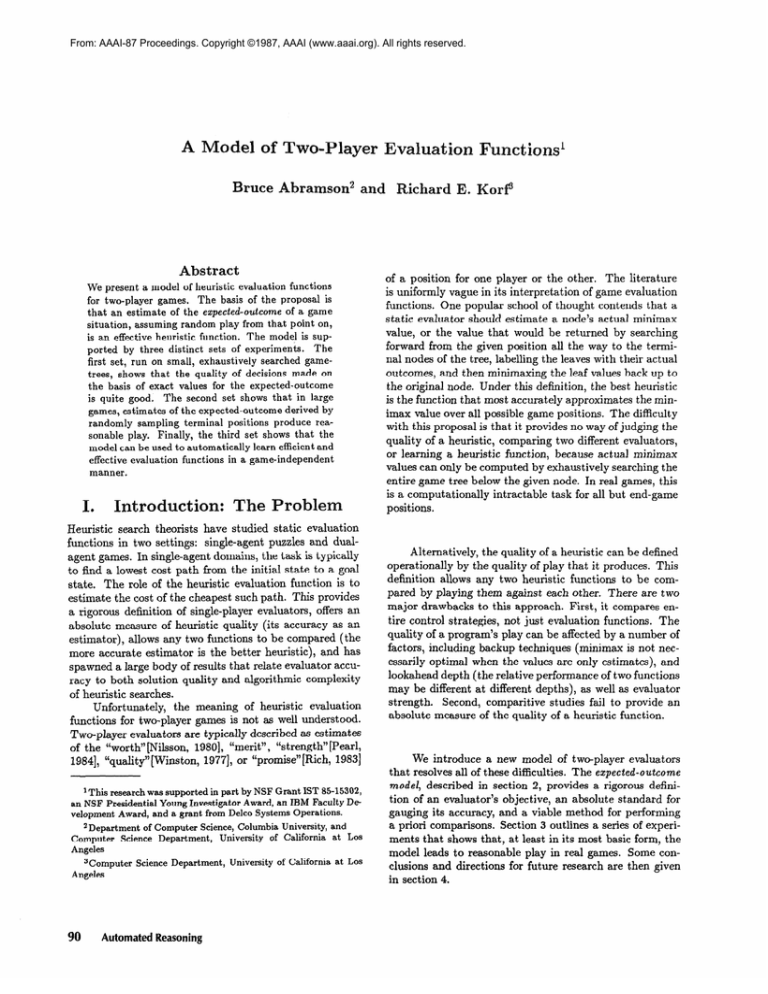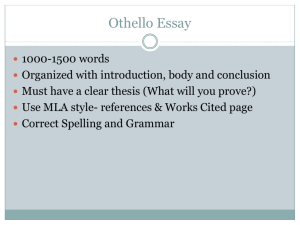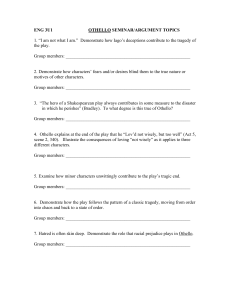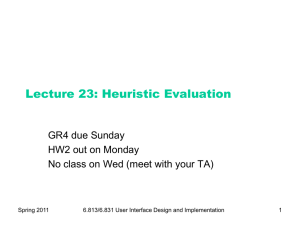
From: AAAI-87 Proceedings. Copyright ©1987, AAAI (www.aaai.org). All rights reserved.
A Model
of Two-Player
Bruce
Abramson
and
Abstract
Introduction:
Heuristic
search theorists
functions
in two settings:
The
absolute
estimator),
definition
evaluation
of single-player
of heuristic
quality
allows any two functions
more accurate
estimator
literature
should estimate
a node’s
actual minimax
imax value over all possible game positions. The difficulty
with this proposal is that it provides no way of judging the
quality of a heuristic, comparing
or learning a heuristic function,
two different evaluators,
because actual minimax
values can only be computed by exhaustively searching the
entire game tree below the given node. In real games, this
is a computationally
intractable task for all but end-game
positions.
is the better
function
is to
This provides
evaluators,
offers an
(its accuracy
as an
to be compared
(the
heuristic),
and has
quality
and algorithmic
complexity
Unfortunately,
the meaning
of heuristic
evaluation
functions for two-player games is not as well understood.
Two-player
evaluators are typically described as estimates
of the “worth” [Nilsson, 19801, “merit”,
“strength” [Pearl,
19831
19841, “quality”[W ins t on, 19771, or “promise”[Rich,
‘This research was supported in part by NSF Grant IST 85-15302,
an NSF Presidential Young Investigator Award, an IBM Faculty Development Award, and a grant from Delco Systems Operations.
2Department of Computer Science, Columbia University, and
Computer Science Department, University of California at Los
Angeles
3Computer Science Department, University of California at Los
Angeles
90
The
the original node. Under this definition, the best heuristic
is the function that most accurately approximates the min-
spawned a large body of results that relate evaluator accuracy to both solution
of heuristic searches.
or the other.
value, or the value that would be returned by searching
forward from the given position all the way to the terminal nodes of the tree, labelling the leaves with their actual
outcomes, and then minimaxing the leaf values back up to
domains, the task is typically
role of the heuristic
measure
for one player
static evaluator
The Problem
the cost of the cheapest such path.
a rigorous
E. Kor@
is uniformly vague in its interpretation
of game evaluation
functions. One popular school of thought contends that a
to find a lowest cost path from the initial state to a goal
estimate
Functions1
have studied static evaluation
single-agent puzzles and dual-
agent games. In single-agent
state.
Richard
of a position
We present a model of heuristic evaluation functions
for two-player games. The basis of the proposal is
that an estimate of the expected-outcome of a game
situation, assuming random play from that point on,
is an effective heuristic function. The model is supported by three distinct sets of experiments.
The
first set, run on small, exhaustively searched gametrees, shows that the quality of decisions made on
the basis of exact values for the expected-outcome
is quite good. The second set shows that in large
games, estimates of the expected-outcome derived by
randomly sampling terminal positions produce reasonable play. Finally, the third set shows that the
model can be used to automatically learn efficient and
effective evaluation functions in a game-independent
manner.
I.
Evaluation
Automated Reasoning
Alternatively,
the quality of a heuristic can be defined
operationally
by the quality of play that it produces. This
definition
allows any two heuristic
pared by playing
major drawbacks
tire control
strategies,
quality of a program’s
factors,
including
functions
to be com-
them against each other. There are two
to this approach. First, it compares ennot just evaluation
functions.
The
play can be affected by a number of
backup techniques
(minimax
is not nec-
essarily optimal when the values are only estimates), and
lookahead depth (the relative performance of two functions
may be different at different depths), as well as evaluator
strength.
Second, comparitive studies fail to provide an
absolute measure of the quality of a heuristic function.
We introduce a new model of two-player evaluators
that resolves all of these difficulties. The expected-outcome
model, described in section 2, provides a rigorous definition of an evaluator’s
objective, an absolute standard
for
gauging its accuracy, and a viable method for performing
a priori comparisons. Section 3 outlines a series of experiments that shows that, at least in its most basic form, the
model leads to reasonable play in real games. Some conclusions and directions for future research are then given
in section 4.
II.
Expected-Outcome:
The
values can be approximated
by random sampling. Along
with their many advantages, of course, expected values
(and other statistical parameters) do bear a serious onus:
el
In a broad sense, the purpose of an evaluation
function
in
a two-player domain is to indicate whether a given node
on the search frontier will result in a victory.
The standard assumption,
ing minimax
estimate
forwarded
by proponents
of approximat-
values, has been that this corresponds
to an
set of assump-
tions. We view the actual outcome of a game as a random
variable and investigate what the game’s payoff would be,
given random
play by both sides.
Although
atively
small.
heavily
on expected-outcome
Most
of the outcome that would be arrived at by perfect
play. Our new model is based on a different
they can be very misleading
the assump-
complex
Thus,
interesting
it is possible
branching
factors
make optimal
sizes &re rel-
values in end-game
games
and irregular
though
when population
care must be taken not to rely too
generate
play.
trees that
to be discussed
are too
analytically.
Al-
to show that on trees with uniform
and depths expected-outcome
decisions,
when the uniformity
functions
disappears,
the guaranteed optimality is lost. Since the ultimate criterion by which an evaluator is judged is its performance
tion of random play seems unrealistic, it is important to
recall that in a two-player game, evaluation functions are
in actual
normally
strength of our model in real games. In the first set, we
generated the complete game-trees of tic-tat-toe and 4by-
applied
definition,
only at the frontier
the frontier
of the search.
is the limit beyond
By
which the pro-
competition,
to verify
gram cannot gather any further data about the game tree,
and in the absence of any other information, random play
and draws beneath
is the only practical
act expected-outcome
common
belief
assumption.
that any player,
Furthermore,
including
should find it easier to win from a “strong”
there is a
a random
one,
position
than
from a “weak” one. Thus, a technique for determining
strong positions for a random player may help indicate
strong
positions
our approach
for a perfect
and the question
intuitive.
Any
one, as well.
stands in stark contrast
effective
of its utility
evaluator
is primarily
designed
In any event,
to the usual one,
empirical,
not
under our assump-
Cons should indicate the expected value of the outcome
variable, or the ezpected-o&come
of the given position.
Expected-Outcome
Definition:
The expected-outcome
value of a game-tree node, G,
is given by a player’s expected payoff over an infinite number of random
completions
4 Othello,
of a game beginning
at G, or
calculated
to that
a leaf’s
value, and Pleaf
reached,
given random
of leaves in the subtree,
is the probability
play.
Vl,,f
is
that it will be
It is important
to note that
Pleaf is not necessarily equal to i. The probability that a
leaf will be reached is one over the product of its ancestors’
Ignoring
the issue of plausibility
factors,
thereby
for a moment,
this
model has a number of attractive features. First, it is precise. Second, it provides an absolute measure of heuristic
quality, (namely the accuracy with which it estimates the
expected value), hence a means of directly comparing two
heuristic functions. Finally, and most importantly, it provides a practical means of devising heuristics - expected
the exstanda’rd
evaluators.
While
these results
this game is too large for exact values to be calculated,
we
the given node. This estimated expected-outcome
evaluation was pitted directly (no lookahead) against a standard
with
the result that expected-outcome
cantly outplayed
the standard.
Unfortunately,
signifi-’
the cost of
implementing
the random sampler was prohibitive.
In the
final set, we attempted to produce an eficient estimator by
a regression
returned
analysis on the expected-outcome
by the sampler,
in a polynomial
to automatically
learn
evaluator for Othello.
Once
again,
the results were positive:
played
as well as a set of coefficients
signed by an expert,
the learned
even though
coefficients
that had been de-
the learning
procedure
had no information
about the game other than the rules
and the values of terminal positions.
Taken as a whole,
this series of experiments
for the expected-outcome
branching factors; a node with no siblings is twice as likely
to be reached as a node with one sibling. Leaves are only
equiprobable in trees in which all nodes of equal depth are
constrained to have identical branching
making all paths equally likely.
of wins, losses,
and compared
estimated expected-outcome
by averaging the values of a
randomly sampled subset of the terminal positions beneath
the coefficients
k is the number
numbers
function with a well-known
of the standard
estimates
where
the exact
every position,
and the
are encouraging, they are limited to games that are small
enough to be searched exhaustively.
In the second set of
experiments, we used the full 8-by-8 game of Othelld. Since
performing
leaf=1
of our assumptions
evaluator for the same game. We found that the quality
of the decisions made by expected-outcome
was superior
evaluator,
Values
we ran three sets of experiments
both the rationality
offers strong
porting
0
empirical
support
model.
E-vi
One of the most attractive features of expected-outcome
is its domain-independence.
The model’s reliance on nothing more than a game’s rules and outcomes indicates that
it should
be equally
applicable
to all two-player
games.
In addition to being a source of great strength, however,
this generality also makes the model somewhat difficult
to test thoroughly.
Different
implementations
ent games are quite likely to yield different
section describes
a series of experiments
on differ-
results.
This
that demonstrate
Abramson and Kopf
91
the utility
of expected-outcome
to at least one class of
tic-tat-toe
[Nilsson,
19801, and a weighted-squares
function
games, those with finite-depth trees and outcomes drawn
The requirement of finite-depth
from (win, loss, draw}.
for Othello based on the one in [Maggs, 19791. Open-linesadvantage is known to be a powerful evaluator; weighted-
trees simply
squares is less so. Nevertheless,
entific merit. Weighted-squares
means that the game will eventually
termi-
nate. Without
this rule, a chess game could, at least in
theory, continue indefinitely.
Variants of two games that
meet both requirements,
lected
for testing.
familiar
larity,
Tic-tat-toe
to everyone;
may not be.
8-by-8 board.
tic-tat-toe
Othello,
The
and Othello,
is a game
although
standard
were se-
that should be
large part due to the feedback provided by their perfor19821. Since the purpose of these
[Rosenbloom,
popu-
mance
is played
on an
experiments
game
on one side and black on the other.
expert-designed
Othello functions, and the more sophisticated championship-level
evaluators became possible in
of growing
The playing pieces are discs which are white
Each player, in turn,
oriented
was not to develop
Othello
quality
comparison
Whenever
specific function,
a sandwich con-
sisting of an unbroken straight line of hostile discs between
two friendly
flipped
ones, the entire opposing
line is captured
to the color of the current mover.
A move is legal
if and only if at least one disc is captured.
player can move,
When
(For a more detailed description,
19801 [Maggs, 19791 [Rosenbloom, 19821).
The
Decision
fist
neither
the one with the most discs is declared
the winner.
A.
and
see [Frey,
a model’s
theoretical
accu-
racy is investigating
its decision quality, or the frequency
with which it recommends correct moves. In the case of
expected-outcome,
the question is how often the move with
the largest (or smallest, as appropriate)
percentage
leaves beneath it is, in fact, optimal. Since optimal
of win
moves
are defined by complete minimax searches, (searches that
extend to the leaves), their calculation is contingent upon
knowledge
of the entire subtree beneath
them.
Thus, for
this first set of experiments, fairly small games had to be
chosen. Moreover, in order to compare the decision quality
of expected-outcome
with that of a more standard
func-
their most significant
was the evaluators’ relative
and in Othello
about one-third
as many as weighted
is
squares.
The b asic point made by these experiments
expected-outcome
model has passed the first test:
values generally lead to good moves.
B.
Random
Sampling
imum
win percentage
matter,
heuristic)
The other two, 4-by-4 tic-tat-toe
The
some method
values based
obvious
outcome
technique
values,
means of leaf-value
portions of their trees to be examined, yet large enough to
offer more interesting testbeds than their smaller cousins.
periments,
was considered
complete-minimax,
expected-outcome,
ied standard, and worst-possible-choice.
by four functions:
a previously studThe decisions rec-
ommended by these evaluators were compared with the optimal move, or the move recommended by minimax, and a
record was kept of their performance.
Minimax, by definition, never made an error, and worst-possible-choice
erred
Expected-outcome,
unlike completewhenever possible.
minimax, did not back up any of the values that it found
at the leaves; its decisions were based strictly on evaluations of a node’s successors. Finally, the standard evaluators were taken from published literature and calculated
using only static information:
the open-lines-advantage
for
on partial
beneficial.
Unfortu-
very
distributions.
a sampler-based
when knowl-
of estimating
expected-
information
is needed.
sampling.
Expected-
is random
by their
ello, were chosen because they are small enough for large
For each game studied, every node in the tree (beneath
is frequently
models are only interesting
have game-trees
and 6-by-6 Oth-
Strategies
nately, these are precisely the cases in which optimal moves
Since probabilistic
(and for that
can always be made.
Othello,
that are small enough to generate
exact
According to the the decision quality results, if complete
information
is available, moving in the direction of max-
entirely.
and 4-by-4
not only made
but chose the
optimal move with relatively high frequency.
This indicates that guiding play in the direction of maximum win
percentage constitutes a reasonable heuristic.
Thus, the
outcome
Automated Reasoning
feature
were rather intergoing into detail,
error-frequency
- in tic-tat-toe,
expected-outcome
made
roughly one-sixth as many errors as open-lines-advantage,
only
3-by-3 tic-tat-toe
a useful
albeit less-than-best.
though
92
functions,
results of these experiments
Without
and quite positive.
esting
performance-
by any well thought out game-
The
edge is incomplete,
the initial configuration)
of evaluation
can be provided
tion, popular games (or variations thereof) were needed.
Four games that met both requirements were studied, altwo of them,
a powerful
but rather to test the decision
that in all cases tested, expected-outcome
fewer errors than the standard functions,
Quality
step in determining
program,
of a new model
fills a legal vacant square with a disc showing his own color.
the newly placed disc completes
its study does have sciwere the first reasonable
definition,
represent
estimate
of expected-outcome
was pitted against a weighted-squares
function
matches of (8-by-8) Othello. These experiments,
which investigated
tests of evaluator
head.
The
the
In the second set of exin several
like those
decision quality, were designed as pure
strength -
neither player used any looka-
aim of these tests,
then,
was to show
that
sampler-based functions can compete favorably with those
designed by experts, at least in terms of their quality of
play. As far as efficiency goes, there is no comparison.
The
sampler
was fairly
cautious
in its detection
of con-
vergence to a value; many samples were taken, and as a
result, the sampling player frequently required as much as
an hour to make a single move 4. The static function,
4Convergence was detected by first sampling N leaves and developing an estimate, then sampling an additional N and finding
on the other hand, never required more than two seconds.
be applicable
The
features and expected-outcome
values. While this reliance
on predetermined
game features will inevitably limit con-
time
invested,
however,
was quite worthwhile:
in a
50-game match, the sampler crushed its weighted-squares
opponent, 48-2.
Veteran
0 the110 players may feel that the number of
formity
to learning
to the model’s
backbone
the relationship
between
ideal, scoring polynomials,
of most competitive
game programs,
game
are the
and if done
victories alone is insufficient to accurately gauge the relative strength of two players. Perhaps of even greater sig-
properly, the learned functions should combine the statistical precision and uncomplicated design of sampler-based
nificance
functions
is the margin
of victory
-
the single most im-
with the implementation
efficiency
of static eval-
portant feature in determining a player’s USOA (United
States Othello Association)
rating [Richards, 19811. Over
uators.
The next set of experiments
involved learning
static expected-outcome
estimators of just this sort.
the course of 50 games, the weighted-squares
total of 894
discs was 1,079 shy of the 1,973 racked up by the sampler.
To find a member of the weighted-squares family that
estimates the expected-outcome
value, a regression proce-
A statistical analysis of the disc differentials indicates that
the sampler should be rated roughly 200 points, or one
dure was used to learn coefficients for the features identified by the original, expert-designed
function. Since the
player class, ahead of the weighted-squares
exact expected-outcome
player.
value is not computable
in inter-
These studies show that, efficency
considerations
aside, sampler-based functions can compete admirably. It
esting games, an estimated value had to be used as the
regression’s dependent variable. Thus, the value that was
is important,
approximated
was not the actual expected-outcome,
but
rather the estimate generated by the random sampler de-
perspective.
however,
to keep the results in their proper
As a demonstration
of the world’s
best Oth-
ello evaluator, they are woefully inadequate - the absence
of lookahead makes the games unrealistic, the difference in
computation times skews the results, and the competition
scribed in the previous section. The output of the regression led directly to the development of static estimators of
the desired
form.
is not as strong
relationship
between
as it could
be.
Their
sole purpose
was
to establish estimated expected-outcome
as a function at
least on par with those designed by experts, and the data
ables indicated
clearly
This is directly
substantiates
the claim.
Expected-outcome
func-
sonable,
In addition,
that
the selected
albeit imprecise,
ing settings.
to
championship
play, additional
evaluate only leaves, and a good deal of computation time,
they were able to play better than a function that had been
[Rosenbloom,
19821.
hand-crafted
bers of the weighted-squares
no expert
by an expert.
been met, as well:
an expected-outcome
information,
the ability
Thus the second challenge
in the absence of perfect
estimator
has
information,
made reasonably
good de-
cisions.
C.
earning
tions
ExpectecL0utcor-m
Fuuc-
inefficiency of sampler-based functions is accrued during
implementation;
their design is simple and cheap, because
an effective
sampler need only understand
and be able to identify
other
hand,
quently
leaves.
rely on detailed
Static
the game’s rules
evaluators,
game-specific
at the cost of many man-hours
on the
analyses,
and/or
fre-
machine-
hours. To help reduce these design costs, a variety of automatic tools that improve static evaluators
have been devel-
oped, the simplest of which attempt to determine the relative significance of several given game features. Techniques
learning [Samuel, 19631
of this sort are called parameter
[Samuel, 19671 [Christensen and Korf, 19861, and should
another estimate. If the discrepancy between them was within the
tolerable error bounds, the estimate was accepted. Otherwise, another 2N were sampled, and so on, until convergence was detected.
For the sampler used in these experiments, the original sample size
was iV = 16 leaves, and the maximum needed was 1024.
can play up to a certain
factors
were studied,
two of expert
regression analysis.
coefficients
assigned
ascertain
that weightedlevel,
four mem-
of Othello
evaluators
design ’ and two learned
strength
was played.
quality
but for
must be considered
by
These evaluators differ only in the
to each of the game features.
To
the relative
tournament
family
vari-
are rea-
of expected-outcome.
For the third, and final set of experiments,
the decision
Like most products, evaluation functions incur costs in two
phases of their existence, design and implementation.
The
features
to the assertion
squares functions
measures of
and dependent
game
estimators
analogous
tions, then, do appear to make useful decisions in interestGiven
the statistical
the independent
of the coefficient
Unlike
and random
the functions
sampling
sets,
studied
a
in
experiments,
all four weighted-squares
evaluators are efficiently calculable. This allowed the ban on lookahead to be lifted and
more realistic games to be studied. The rules of the tournament were simple. Every pair of functions met in one
match, which consisted
of 100 games each with lookahead
length fixed at 0, 1, 2, and 3. Between games, the players
swapped colors. Over the course of 400 games, no evabuator was able to demonstrate
substantial superiority
over
any other. Not only were the scores of all matches fairly
close, but the disc differential statistics were, as well. An
analysis of the victory margins shows that with probability .975, no two of the functions would be rated more than
Since roughly 290 points (actupoints apart.
35 USOA
ally, 207 [Richards, 1981]), are necessary to differentiate
between player classes, the rating spread is rather insignif-
5The first expert function was taken directly from [Maggs>1979],
while the second, which was also used in the previous section’s random sampling experiments, modified the first to account for my personal experience.
Abramson and Korf
93
icant -
it should be clear that all four functions
sent ially equivalent.
are es-
In addition to offering a method of comparing evaluator strength, disc differentials suggest another application of expected-outcome:
to the expected
assign each node a value equal
disc-differential
A fifth weighted-squares
the expected-outcome
tion (all outcomes
entered
in the range [-64,641
leaf distribu-
are possible),
Its performance
so, with victory
margins
and
was notice-
than that of the other functions,
not overwhelmingly
it.
was learned to estimate
of this multi-valued
into the tournament.
ably stronger
of the leaves beneath
function
although
between
implementation
of any new
the coefficients
ysis procedure
learned by the regression
are at least as good
by
experts.
Of course, it is possible to contend that a function’s strength is derived primarily from its feature set,
not its coefficient set. If this is true, any two members of
the same family should perform comparably, and it’s not
surprising that the new functions competed favorably with
the old. To dissipate any doubts that may arise along these
lines, some further family members were generated. Each
of the four evaluators in the initial tournament played an
additional
match
against
a weighted-squares
of inher-
game design, or simply augment
it by providing
a degree
of precision to some of its more ambiguous components,
remains to be seen. What this paper has shown is that the
estimation
of expected-outcome
domain-independent
functions
defines a viable,
role for two-player
evaluation
func-
tions. We believe that the new model warrants the serious
further
study that is currently
in progress.
39
anal-
as those designed
regardless
to match the achievements of thirty-five years
Whether expected-outcome
will
of progressive research.
eventually replace minimax as the standard model for
Acknowledgements
and 145, and ratings 25 to 85 points above its competitors.
Thus,
model,
ent merit,
cousin with
We
would
like
to
thank
Othar
Hansson,
Andrew
Mayer, Dana Nau, and Judea Pearl for providing
helpful discussions and suggestions.
us with
References
[Christensen and Korf, 19861 Jens
Christensen and Richard Korf.
A unified theory of
heuristic evaluation functions and its application to
learning. In Proceedings of the fifth National Conference on Artificial Intelligence,
1986.
Personal
a randomly generated set of coefficients. All four random
functions were demolished - they rarely won at all, and
[Frey, 19801 Peter W. Frey.
Machine
Computing,
:89-90, 1980.
would be rated at least a player class behind the four that
had been intelligently designed. With its strong showing in
[Maggs, 19791 Peter B. Maggs. Programming
strategies
the game of reversi. BYTE, 4:66-79, 1979.
the tournament,
the expected-outcome
[Nilsson,
third challenge:
an effeciently
fairly
model has met the
calculable
estimator
played
well.
Our proposed
Conclusions
model
the expected-outcome
of two-player
model,
virtually
For example,
in addition
Wesley,
evaluation
functions,
suggests new directions
every element
orous and practical
to the obvious benefits
definition
for
of game programming.
for evaluators,
of a rig-
the model
implies a significantly different approach to the programming of two-player games. The standard Shannon TypeA program does a full-width search to a fixed depth and
then estimates the values of the nodes at that depth [Shannon, 19501. The program in the second set of experiments
(random
Tioga
Publishing
sampling)
does a full-depth
search but only of a
of Artificial
Company,
[Pearl, 19841 Judea Pearl.
Heuristics:
Strategies for Computer
Problem
IV.
rethinking
Principles
19801 Nils J. Nilsson.
telligence.
Othello.
in
In-
1980.
Intelligent
Search
Solving.
Addison
1984.
[Rich, 19831 El aine Rich.
Artificial
Intelligence.
McGraw
Hill, 1983.
[Richards,
tem.
19811 R. Richards.
Othello
[Rosenbloom,
Quarterly,
19821 Paul
championship-level
19631 A.L.
S.
world-
Artificial
Intel-
1982.
Samuel.
J. Feldman,
McGraw-Hill,
A
Rosenbloom.
Some
studies
learning using the game of checkers.
and
1981.
Othello program.
ligence, 19:279-320,
[Samuel,
The revised usoa rating sys3( 1):18-23,
Computers
editors,
in machine
In E. Feigenbaum
and
Thought,
1963.
subset of the nodes. In a Shannon type-A strategy, uncertainty comes from the estimates of the positions at the
search horizon,‘whereas
in our model, uncertainty is due
[Samuel, 19671 A.L.
learning using
to sampling
Programming
a
[Shannon, 19501 Claude E. Shannon.
computer for playing chess. 1Philosoyh4cal Magazine,
of the major
error.
Furthermore,
disadvantages
the new model avoids one
of all previous approaches,
the
need for a game-specific evaluation function based on a set
of handcrafted, carefully tuned, ad hoc features. In sharp
contrast to this reliance on outside expertise, the expectedoutcome model requires only well-defined leaf values, the
rules of the game, and a game-independent
sampling
strat-
egy.
It is, of course,
94
unreasonable
Automated Reasoning
to expect
the
initial
progress.
IBM
41:256-275,
[Winston,
Some studies in machine
Samuel.
the game of checkers ii recent
J. Res. Bev.,
1967.
1950.
19771 P.H. Winston.
dison Wesley,
11:601-617,
1977.
Artificial
Intelligence.
Ad-










